Analysis of Professional Care by Nurses: A Case Study
VerifiedAdded on 2022/10/08
|7
|1652
|14
Case Study
AI Summary
This case study examines a situation where a patient died due to medical negligence within a healthcare setting. The analysis focuses on the lack of collaboration, poor communication, and delayed responses from healthcare professionals, particularly nurses, leading to a critical deterioration in the patient's condition. The study highlights the importance of timely interventions, effective communication using tools like ISBAR, and adherence to professional standards. It explores the implications of these failures, including missed diagnoses, inadequate time management, and the absence of a proactive approach to patient care. The case emphasizes the significance of clinical expertise, the need for organizational resources, and the implementation of training programs to minimize medical errors and improve patient safety. The study concludes with recommendations for future practice, including the need for improved communication, strict adherence to professional standards, and the importance of continuous education to address potential gaps in healthcare delivery. The lack of immediate response to the patient's declining vital signs, failure to involve senior staff promptly, and the delay in providing necessary medical treatment are central to the discussion.
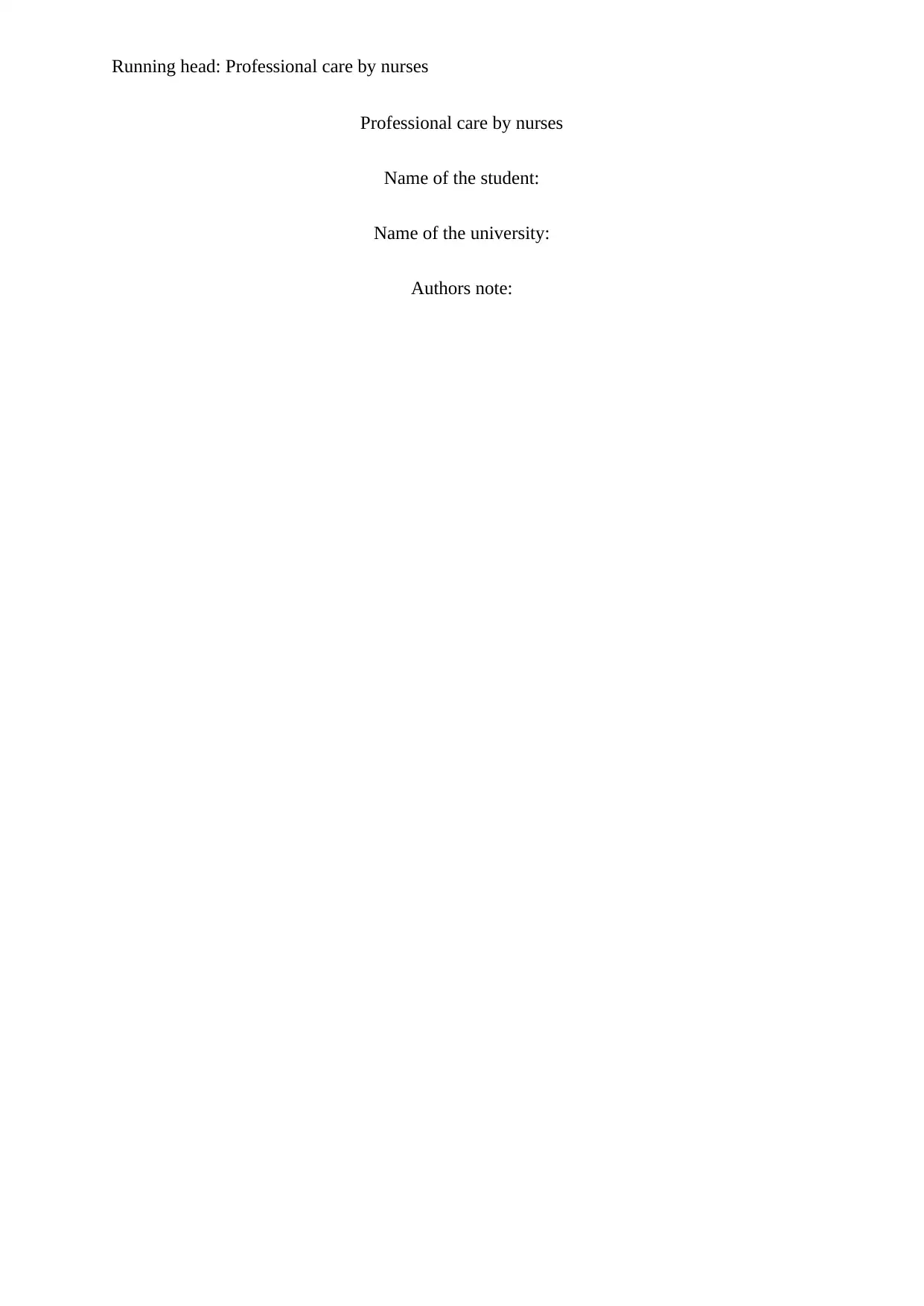
Running head: Professional care by nurses
Professional care by nurses
Name of the student:
Name of the university:
Authors note:
Professional care by nurses
Name of the student:
Name of the university:
Authors note:
Paraphrase This Document
Need a fresh take? Get an instant paraphrase of this document with our AI Paraphraser
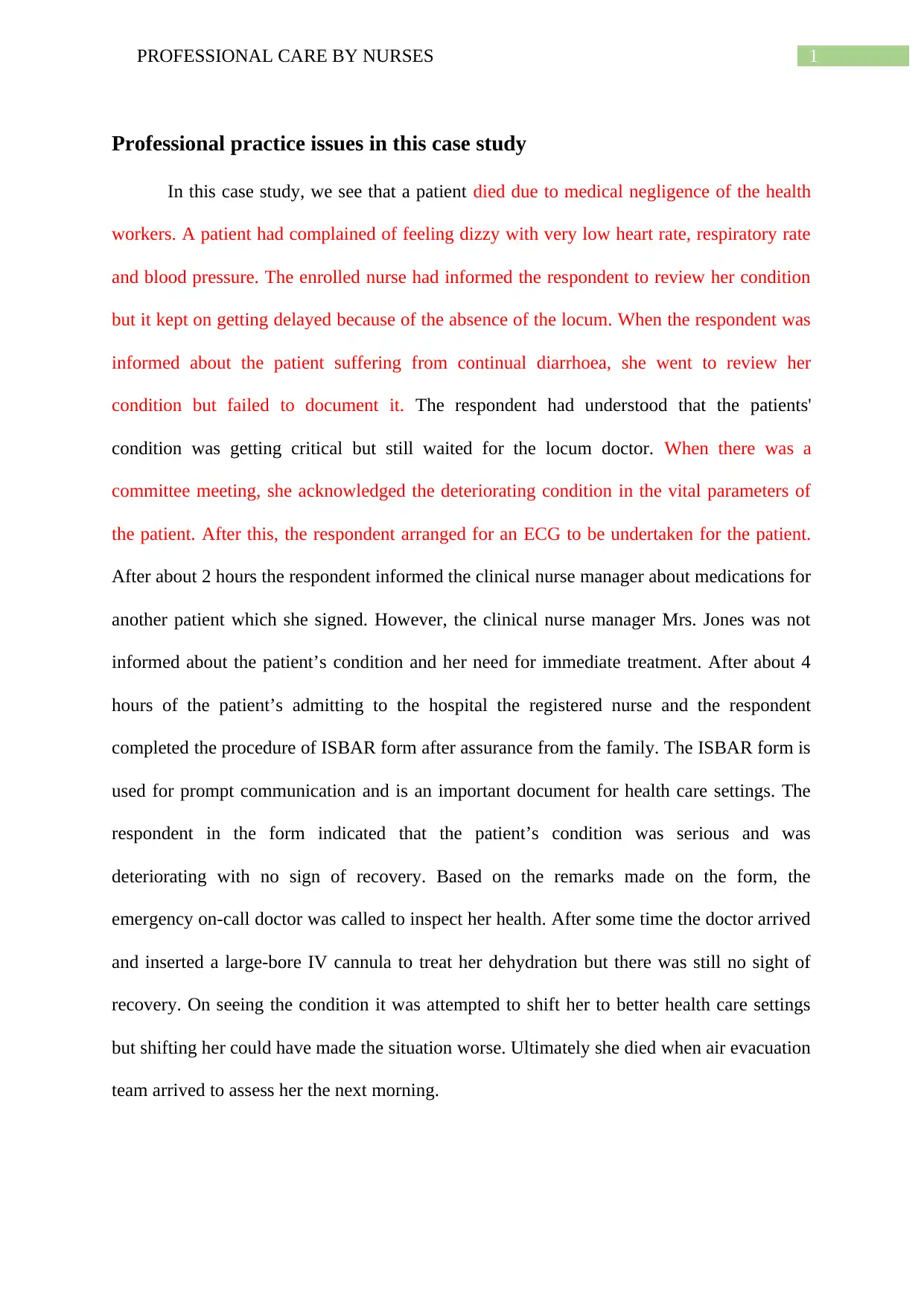
1PROFESSIONAL CARE BY NURSES
Professional practice issues in this case study
In this case study, we see that a patient died due to medical negligence of the health
workers. A patient had complained of feeling dizzy with very low heart rate, respiratory rate
and blood pressure. The enrolled nurse had informed the respondent to review her condition
but it kept on getting delayed because of the absence of the locum. When the respondent was
informed about the patient suffering from continual diarrhoea, she went to review her
condition but failed to document it. The respondent had understood that the patients'
condition was getting critical but still waited for the locum doctor. When there was a
committee meeting, she acknowledged the deteriorating condition in the vital parameters of
the patient. After this, the respondent arranged for an ECG to be undertaken for the patient.
After about 2 hours the respondent informed the clinical nurse manager about medications for
another patient which she signed. However, the clinical nurse manager Mrs. Jones was not
informed about the patient’s condition and her need for immediate treatment. After about 4
hours of the patient’s admitting to the hospital the registered nurse and the respondent
completed the procedure of ISBAR form after assurance from the family. The ISBAR form is
used for prompt communication and is an important document for health care settings. The
respondent in the form indicated that the patient’s condition was serious and was
deteriorating with no sign of recovery. Based on the remarks made on the form, the
emergency on-call doctor was called to inspect her health. After some time the doctor arrived
and inserted a large-bore IV cannula to treat her dehydration but there was still no sight of
recovery. On seeing the condition it was attempted to shift her to better health care settings
but shifting her could have made the situation worse. Ultimately she died when air evacuation
team arrived to assess her the next morning.
Professional practice issues in this case study
In this case study, we see that a patient died due to medical negligence of the health
workers. A patient had complained of feeling dizzy with very low heart rate, respiratory rate
and blood pressure. The enrolled nurse had informed the respondent to review her condition
but it kept on getting delayed because of the absence of the locum. When the respondent was
informed about the patient suffering from continual diarrhoea, she went to review her
condition but failed to document it. The respondent had understood that the patients'
condition was getting critical but still waited for the locum doctor. When there was a
committee meeting, she acknowledged the deteriorating condition in the vital parameters of
the patient. After this, the respondent arranged for an ECG to be undertaken for the patient.
After about 2 hours the respondent informed the clinical nurse manager about medications for
another patient which she signed. However, the clinical nurse manager Mrs. Jones was not
informed about the patient’s condition and her need for immediate treatment. After about 4
hours of the patient’s admitting to the hospital the registered nurse and the respondent
completed the procedure of ISBAR form after assurance from the family. The ISBAR form is
used for prompt communication and is an important document for health care settings. The
respondent in the form indicated that the patient’s condition was serious and was
deteriorating with no sign of recovery. Based on the remarks made on the form, the
emergency on-call doctor was called to inspect her health. After some time the doctor arrived
and inserted a large-bore IV cannula to treat her dehydration but there was still no sight of
recovery. On seeing the condition it was attempted to shift her to better health care settings
but shifting her could have made the situation worse. Ultimately she died when air evacuation
team arrived to assess her the next morning.
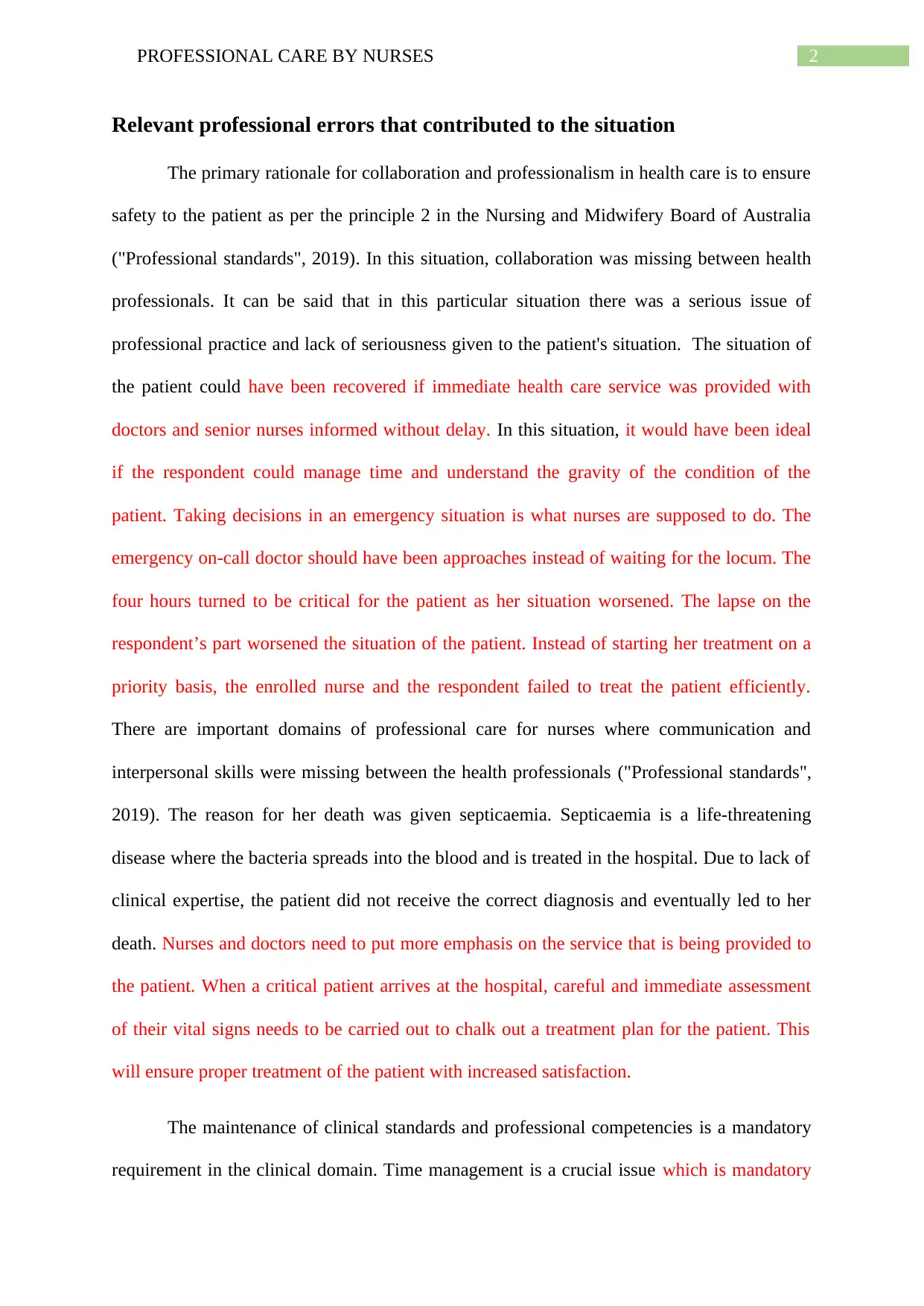
2PROFESSIONAL CARE BY NURSES
Relevant professional errors that contributed to the situation
The primary rationale for collaboration and professionalism in health care is to ensure
safety to the patient as per the principle 2 in the Nursing and Midwifery Board of Australia
("Professional standards", 2019). In this situation, collaboration was missing between health
professionals. It can be said that in this particular situation there was a serious issue of
professional practice and lack of seriousness given to the patient's situation. The situation of
the patient could have been recovered if immediate health care service was provided with
doctors and senior nurses informed without delay. In this situation, it would have been ideal
if the respondent could manage time and understand the gravity of the condition of the
patient. Taking decisions in an emergency situation is what nurses are supposed to do. The
emergency on-call doctor should have been approaches instead of waiting for the locum. The
four hours turned to be critical for the patient as her situation worsened. The lapse on the
respondent’s part worsened the situation of the patient. Instead of starting her treatment on a
priority basis, the enrolled nurse and the respondent failed to treat the patient efficiently.
There are important domains of professional care for nurses where communication and
interpersonal skills were missing between the health professionals ("Professional standards",
2019). The reason for her death was given septicaemia. Septicaemia is a life-threatening
disease where the bacteria spreads into the blood and is treated in the hospital. Due to lack of
clinical expertise, the patient did not receive the correct diagnosis and eventually led to her
death. Nurses and doctors need to put more emphasis on the service that is being provided to
the patient. When a critical patient arrives at the hospital, careful and immediate assessment
of their vital signs needs to be carried out to chalk out a treatment plan for the patient. This
will ensure proper treatment of the patient with increased satisfaction.
The maintenance of clinical standards and professional competencies is a mandatory
requirement in the clinical domain. Time management is a crucial issue which is mandatory
Relevant professional errors that contributed to the situation
The primary rationale for collaboration and professionalism in health care is to ensure
safety to the patient as per the principle 2 in the Nursing and Midwifery Board of Australia
("Professional standards", 2019). In this situation, collaboration was missing between health
professionals. It can be said that in this particular situation there was a serious issue of
professional practice and lack of seriousness given to the patient's situation. The situation of
the patient could have been recovered if immediate health care service was provided with
doctors and senior nurses informed without delay. In this situation, it would have been ideal
if the respondent could manage time and understand the gravity of the condition of the
patient. Taking decisions in an emergency situation is what nurses are supposed to do. The
emergency on-call doctor should have been approaches instead of waiting for the locum. The
four hours turned to be critical for the patient as her situation worsened. The lapse on the
respondent’s part worsened the situation of the patient. Instead of starting her treatment on a
priority basis, the enrolled nurse and the respondent failed to treat the patient efficiently.
There are important domains of professional care for nurses where communication and
interpersonal skills were missing between the health professionals ("Professional standards",
2019). The reason for her death was given septicaemia. Septicaemia is a life-threatening
disease where the bacteria spreads into the blood and is treated in the hospital. Due to lack of
clinical expertise, the patient did not receive the correct diagnosis and eventually led to her
death. Nurses and doctors need to put more emphasis on the service that is being provided to
the patient. When a critical patient arrives at the hospital, careful and immediate assessment
of their vital signs needs to be carried out to chalk out a treatment plan for the patient. This
will ensure proper treatment of the patient with increased satisfaction.
The maintenance of clinical standards and professional competencies is a mandatory
requirement in the clinical domain. Time management is a crucial issue which is mandatory
⊘ This is a preview!⊘
Do you want full access?
Subscribe today to unlock all pages.

Trusted by 1+ million students worldwide
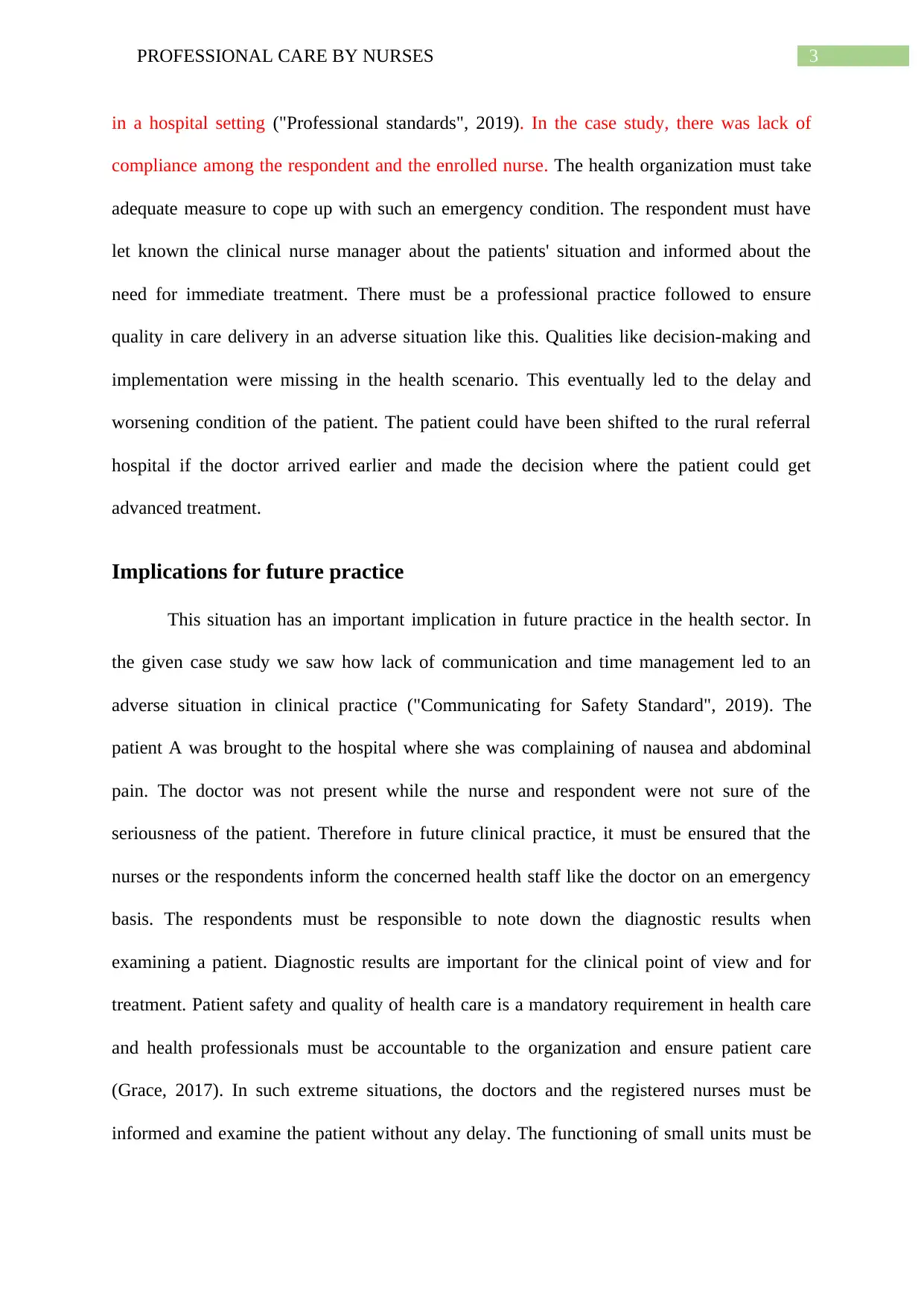
3PROFESSIONAL CARE BY NURSES
in a hospital setting ("Professional standards", 2019). In the case study, there was lack of
compliance among the respondent and the enrolled nurse. The health organization must take
adequate measure to cope up with such an emergency condition. The respondent must have
let known the clinical nurse manager about the patients' situation and informed about the
need for immediate treatment. There must be a professional practice followed to ensure
quality in care delivery in an adverse situation like this. Qualities like decision-making and
implementation were missing in the health scenario. This eventually led to the delay and
worsening condition of the patient. The patient could have been shifted to the rural referral
hospital if the doctor arrived earlier and made the decision where the patient could get
advanced treatment.
Implications for future practice
This situation has an important implication in future practice in the health sector. In
the given case study we saw how lack of communication and time management led to an
adverse situation in clinical practice ("Communicating for Safety Standard", 2019). The
patient A was brought to the hospital where she was complaining of nausea and abdominal
pain. The doctor was not present while the nurse and respondent were not sure of the
seriousness of the patient. Therefore in future clinical practice, it must be ensured that the
nurses or the respondents inform the concerned health staff like the doctor on an emergency
basis. The respondents must be responsible to note down the diagnostic results when
examining a patient. Diagnostic results are important for the clinical point of view and for
treatment. Patient safety and quality of health care is a mandatory requirement in health care
and health professionals must be accountable to the organization and ensure patient care
(Grace, 2017). In such extreme situations, the doctors and the registered nurses must be
informed and examine the patient without any delay. The functioning of small units must be
in a hospital setting ("Professional standards", 2019). In the case study, there was lack of
compliance among the respondent and the enrolled nurse. The health organization must take
adequate measure to cope up with such an emergency condition. The respondent must have
let known the clinical nurse manager about the patients' situation and informed about the
need for immediate treatment. There must be a professional practice followed to ensure
quality in care delivery in an adverse situation like this. Qualities like decision-making and
implementation were missing in the health scenario. This eventually led to the delay and
worsening condition of the patient. The patient could have been shifted to the rural referral
hospital if the doctor arrived earlier and made the decision where the patient could get
advanced treatment.
Implications for future practice
This situation has an important implication in future practice in the health sector. In
the given case study we saw how lack of communication and time management led to an
adverse situation in clinical practice ("Communicating for Safety Standard", 2019). The
patient A was brought to the hospital where she was complaining of nausea and abdominal
pain. The doctor was not present while the nurse and respondent were not sure of the
seriousness of the patient. Therefore in future clinical practice, it must be ensured that the
nurses or the respondents inform the concerned health staff like the doctor on an emergency
basis. The respondents must be responsible to note down the diagnostic results when
examining a patient. Diagnostic results are important for the clinical point of view and for
treatment. Patient safety and quality of health care is a mandatory requirement in health care
and health professionals must be accountable to the organization and ensure patient care
(Grace, 2017). In such extreme situations, the doctors and the registered nurses must be
informed and examine the patient without any delay. The functioning of small units must be
Paraphrase This Document
Need a fresh take? Get an instant paraphrase of this document with our AI Paraphraser
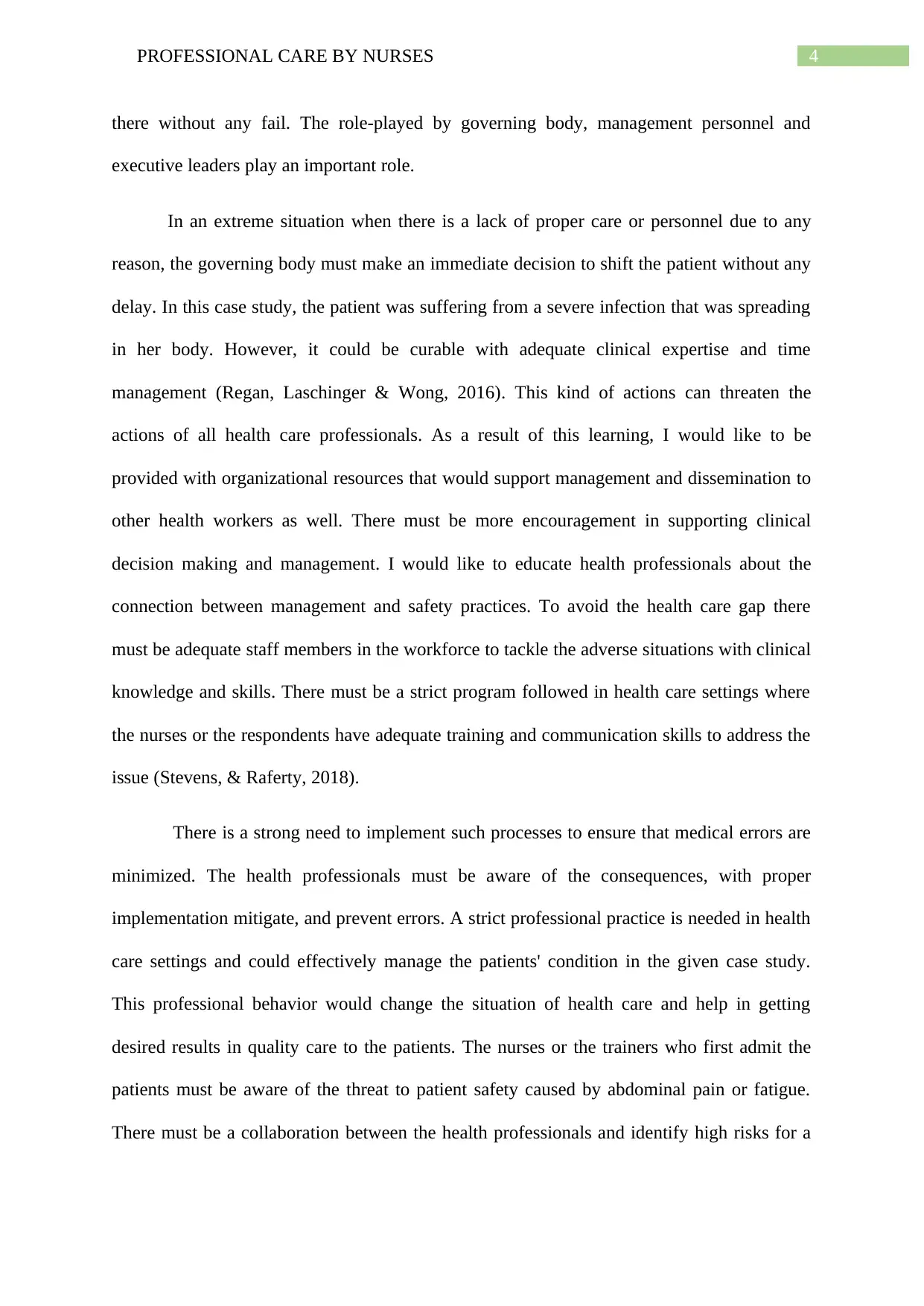
4PROFESSIONAL CARE BY NURSES
there without any fail. The role-played by governing body, management personnel and
executive leaders play an important role.
In an extreme situation when there is a lack of proper care or personnel due to any
reason, the governing body must make an immediate decision to shift the patient without any
delay. In this case study, the patient was suffering from a severe infection that was spreading
in her body. However, it could be curable with adequate clinical expertise and time
management (Regan, Laschinger & Wong, 2016). This kind of actions can threaten the
actions of all health care professionals. As a result of this learning, I would like to be
provided with organizational resources that would support management and dissemination to
other health workers as well. There must be more encouragement in supporting clinical
decision making and management. I would like to educate health professionals about the
connection between management and safety practices. To avoid the health care gap there
must be adequate staff members in the workforce to tackle the adverse situations with clinical
knowledge and skills. There must be a strict program followed in health care settings where
the nurses or the respondents have adequate training and communication skills to address the
issue (Stevens, & Raferty, 2018).
There is a strong need to implement such processes to ensure that medical errors are
minimized. The health professionals must be aware of the consequences, with proper
implementation mitigate, and prevent errors. A strict professional practice is needed in health
care settings and could effectively manage the patients' condition in the given case study.
This professional behavior would change the situation of health care and help in getting
desired results in quality care to the patients. The nurses or the trainers who first admit the
patients must be aware of the threat to patient safety caused by abdominal pain or fatigue.
There must be a collaboration between the health professionals and identify high risks for a
there without any fail. The role-played by governing body, management personnel and
executive leaders play an important role.
In an extreme situation when there is a lack of proper care or personnel due to any
reason, the governing body must make an immediate decision to shift the patient without any
delay. In this case study, the patient was suffering from a severe infection that was spreading
in her body. However, it could be curable with adequate clinical expertise and time
management (Regan, Laschinger & Wong, 2016). This kind of actions can threaten the
actions of all health care professionals. As a result of this learning, I would like to be
provided with organizational resources that would support management and dissemination to
other health workers as well. There must be more encouragement in supporting clinical
decision making and management. I would like to educate health professionals about the
connection between management and safety practices. To avoid the health care gap there
must be adequate staff members in the workforce to tackle the adverse situations with clinical
knowledge and skills. There must be a strict program followed in health care settings where
the nurses or the respondents have adequate training and communication skills to address the
issue (Stevens, & Raferty, 2018).
There is a strong need to implement such processes to ensure that medical errors are
minimized. The health professionals must be aware of the consequences, with proper
implementation mitigate, and prevent errors. A strict professional practice is needed in health
care settings and could effectively manage the patients' condition in the given case study.
This professional behavior would change the situation of health care and help in getting
desired results in quality care to the patients. The nurses or the trainers who first admit the
patients must be aware of the threat to patient safety caused by abdominal pain or fatigue.
There must be a collaboration between the health professionals and identify high risks for a
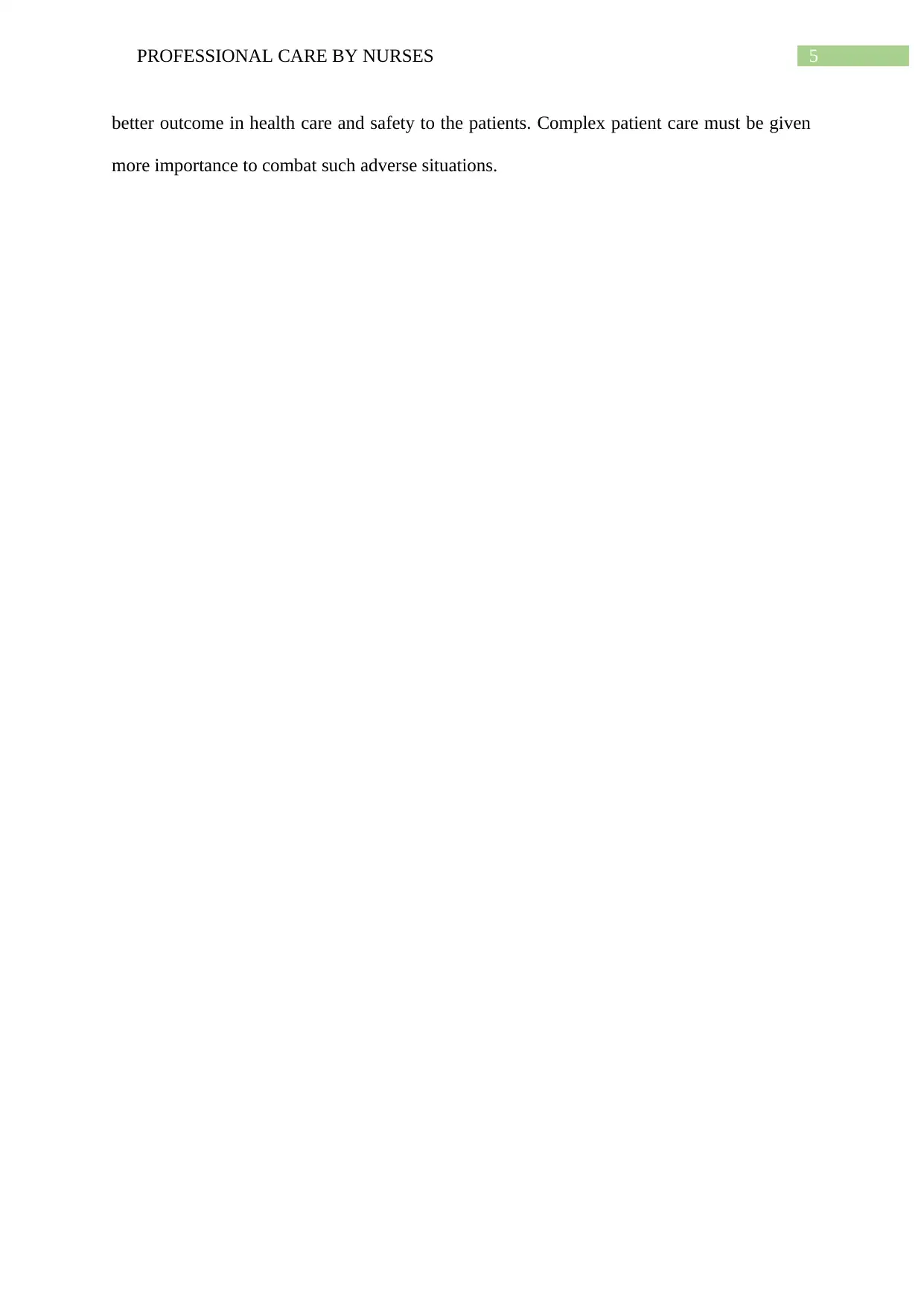
5PROFESSIONAL CARE BY NURSES
better outcome in health care and safety to the patients. Complex patient care must be given
more importance to combat such adverse situations.
better outcome in health care and safety to the patients. Complex patient care must be given
more importance to combat such adverse situations.
⊘ This is a preview!⊘
Do you want full access?
Subscribe today to unlock all pages.

Trusted by 1+ million students worldwide
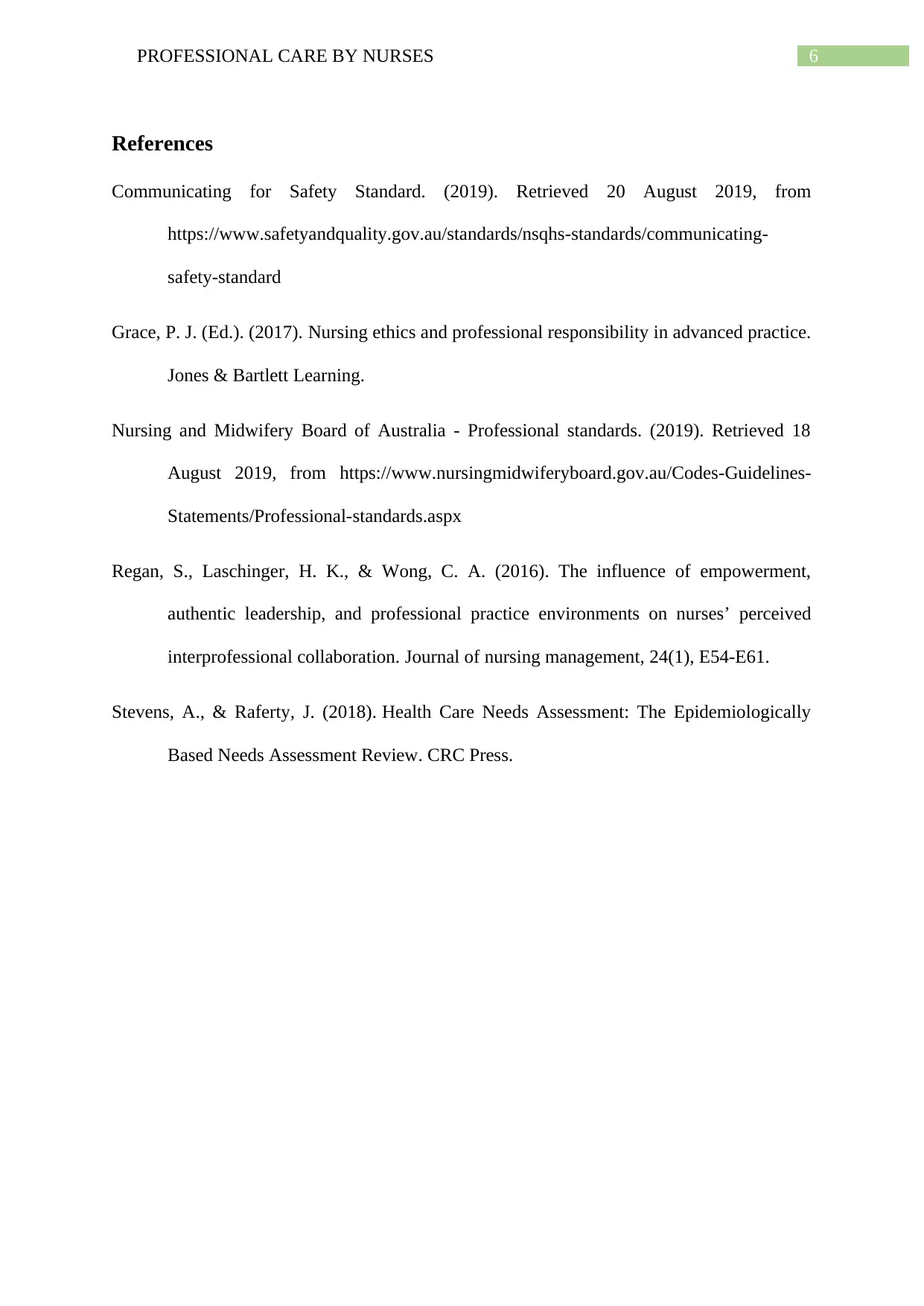
6PROFESSIONAL CARE BY NURSES
References
Communicating for Safety Standard. (2019). Retrieved 20 August 2019, from
https://www.safetyandquality.gov.au/standards/nsqhs-standards/communicating-
safety-standard
Grace, P. J. (Ed.). (2017). Nursing ethics and professional responsibility in advanced practice.
Jones & Bartlett Learning.
Nursing and Midwifery Board of Australia - Professional standards. (2019). Retrieved 18
August 2019, from https://www.nursingmidwiferyboard.gov.au/Codes-Guidelines-
Statements/Professional-standards.aspx
Regan, S., Laschinger, H. K., & Wong, C. A. (2016). The influence of empowerment,
authentic leadership, and professional practice environments on nurses’ perceived
interprofessional collaboration. Journal of nursing management, 24(1), E54-E61.
Stevens, A., & Raferty, J. (2018). Health Care Needs Assessment: The Epidemiologically
Based Needs Assessment Review. CRC Press.
References
Communicating for Safety Standard. (2019). Retrieved 20 August 2019, from
https://www.safetyandquality.gov.au/standards/nsqhs-standards/communicating-
safety-standard
Grace, P. J. (Ed.). (2017). Nursing ethics and professional responsibility in advanced practice.
Jones & Bartlett Learning.
Nursing and Midwifery Board of Australia - Professional standards. (2019). Retrieved 18
August 2019, from https://www.nursingmidwiferyboard.gov.au/Codes-Guidelines-
Statements/Professional-standards.aspx
Regan, S., Laschinger, H. K., & Wong, C. A. (2016). The influence of empowerment,
authentic leadership, and professional practice environments on nurses’ perceived
interprofessional collaboration. Journal of nursing management, 24(1), E54-E61.
Stevens, A., & Raferty, J. (2018). Health Care Needs Assessment: The Epidemiologically
Based Needs Assessment Review. CRC Press.
1 out of 7
Related Documents
Your All-in-One AI-Powered Toolkit for Academic Success.
+13062052269
info@desklib.com
Available 24*7 on WhatsApp / Email
![[object Object]](/_next/static/media/star-bottom.7253800d.svg)
Unlock your academic potential
Copyright © 2020–2025 A2Z Services. All Rights Reserved. Developed and managed by ZUCOL.





